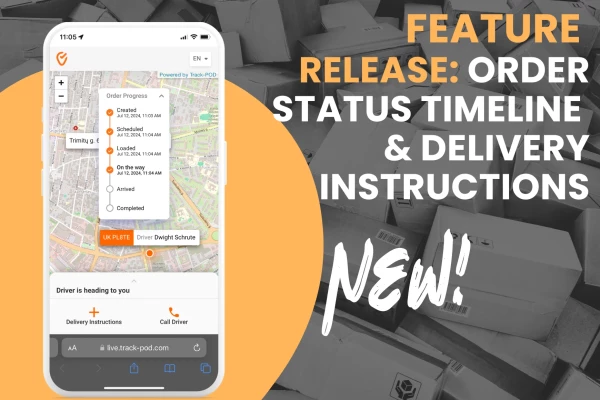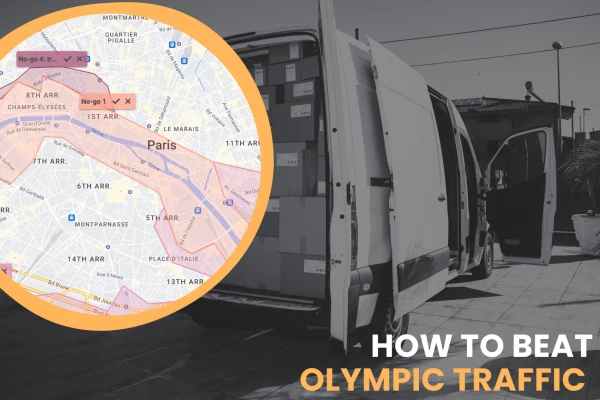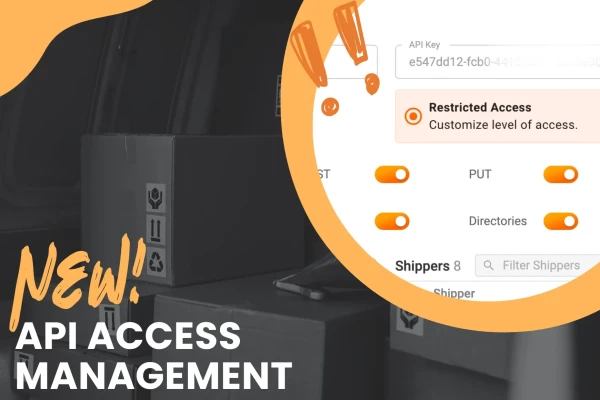8 Steps for Choosing Your TMS [PDF Guide Inside]

by
Yulia Miashkova
July 08, 2021
What can a good transport management software (TMS) system do for you and your business? This is a good question to ask when expanding your business to include delivery services, or if you run a delivery or logistics organization. There are so many things that go into making transportation work efficiently and at optimum standard.
You have to manage your fleet and vehicles. Employees such as your drivers, warehouse and inventory team, and delivery workers need your attention and clear communication. Orders require swift and timely action so that you get them to your customers as quickly as possible. You have to do all these things, and more, with such ease and efficiency that clients and customers think your business runs like a well-oiled machine.
It makes sense that you and your transportation team may need help getting things just right. Fortunately, digital and technological infrastructure continues to evolve so notably that you use a range of tech solutions to achieve a balance and flow in transport management.
Today, we’ll be looking at one type of technological tool, namely TMS systems. We’ll show you what it can do for your business and how you can choose the right one for you.
What is a TMS?
A transport management system or TMS system is a technological platform used for logistics management and tasks.
It can also be referred to as a transport management software or solution, as it gives users control over their daily transport operations. Using a TMS system, you can plan, implement and enhance shipping steps and the transportation of goods. This includes incoming and outgoing products and the insurance of proper package handling and safety.
TMS systems form a vital part of the greater supply chain and logistics management and they’re primarily used by organizations that focus on goods movements like retail, eCommerce, logistics, and other companies.
Why is it important to choose the right TMS solution?
This role of TMS systems in the supply chain means the decision you make when choosing the right system can either positively or negatively affect different elements of your supply chain. In other words, your TMS solution choice can affect your product cycle, logistics planning, procurement, order and inventory management, warehouse control, dispatching, and other areas of your supply processes.
The TMS solution you choose impacts your transport data visibility, transportation planning and management, and the efficiency of your transport operations across all vehicle types.
With customer expectations for convenience, consistency, and easy consumption, there is even more pressure for your transport system to perform well.
Your TMS system can enable you to meet customer demands and provide the best delivery options like fast shipping and real-time tracking. This makes a good TMS system important as it can reduce delivery times, optimize shipping processes, and meet customer shipping demands.
Improvements in these areas can lead to higher sales, business growth, and better delivery performance.
The benefits of choosing a good transport management system
Choosing a good TMS solution or system offers various benefits to your business.
Transportation cost control
Your TMS app or platform can help you cut back on your spending. The software can offer you optimization benefits that can help you get the best returns and reduce the money you put into your transportation. You can also use your TMS app’s data insights and analytics to see where in your operations you can make improvements. Improved data visibility enables you to make informed decisions around your expense reduction.
Route planning and optimization
Route planning and route optimization help you make your trips and shipments more efficient. With the planning and structuring of the routes, you can have shorter and smarter trips that are safer for your drivers and packages. Both route optimization and planning can help you minimize delays, make faster trips, and reduce costs by encouraging shorter trips.
Real-time delivery tracking
GPS capabilities and navigation, which are offered by most TMS’s, mean you can track the location of your goods and drivers in real-time. This is useful for transportation or route managers to monitor trip progress. For last-mile and customer deliveries, it allows customers to keep track of their packages, too. It also allows you to ensure more accurate estimated arrival times.
Order and warehouse management
Your TMS needs to permit and promote better order management. It can help you keep tabs on incoming and outgoing orders and individual order progress. This is important for the maintenance of an organized and easy-to-navigate warehouse system. You can also store order records and track items in your warehouse.

Inventory control
Your TMS can also work together with your inventory management tools to ensure you maintain the required inventory levels. Monitor orders and complete deliveries. Keep an eye on important dates like when you’re expecting incoming shipments. This allows you to strategize better on stock levels to make sure you always have products available for your customers.
Supply chain management
The abilities provided to you, including vehicle tracking, driver tracking, and inventory control, advantage you by helping you boost productivity and efficiency.
Cloud-based data access
When it comes to transport management, paperwork can get overwhelming. You have a range of documents to keep track of, from supplier deals and contracts to Proof of Delivery documents. A TMS can help you protect these important documents by offering you a cloud-based database to keep them in. Having files stored in the cloud makes it easier for your team to access necessary information wherever they need it. That way, you can provide better service and ease your workflow and productivity.
Customer service
All these benefits help you improve your customer service provisions and remain customer-centric. You can avoid delays in shipments, provide more accurate estimated arrival times, and better inform customers about their orders. You can optimize trips and ensure the best service from your business.
These are amazing benefits that can transform your business’s transport operations.
8 steps to choosing the right TMS solution for your organization
You need a well-planned strategy when selecting the right TMS solution for your organization. Here’s one that you can implement in eight easy steps.
1. Identify the issues with your current system
You must note the issues that exist with your current system. These are the problems that your TMS solution would be expected to resolve or deal with to improve your operations. Identifying your issues helps you keep in mind the gaps in your existing structure.
2. Define your business needs and goals
After analyzing your current transport management system, you need to use these insights to define the needs and goals of your transportation operations. These needs and goals should work hand-in-hand with the overarching values and direction of your entire business. After all, your TMS is a major cog in the structure of your organization.
When defining these needs and goals, you must also think about longevity, of course. Finding a TMS system for right now is alright, but what you should aim for is to find one that can grow with you as your business develops. You need a scalable TMS solution that remains capable of updating your transportation system even as your teams, fleet, and operations expand.
3. Explore suitable features
With an overview of your existing operational issues, and your present and future needs and goals, you can whittle down the requirements of your TMS app or TMS solution.
These essential requirements reflect the most important things your business would utilize in the TMS system. When listing these requirements, you must also consult affected departments across your organization that have a stake in the implementation and use of the new TMS solution.
With all requirements at hand, you can then create a list of must-have features for your TMS solution. Some of these you can identify and find out more about by conducting research and reading up on the list of good transport management systems.
4. Decide on a partnering or self-managed system
Another characteristic, if not a functional feature, of your TMS that you have to decide on, is whether it will be partner-managed or you will oversee its implementation and functioning in-house. The latter option is the best if you already have an internal technical or IT department that is capable of understanding and running the system.
This is also a question of the functioning of the system. In other words, does the system function automatically or through a third-party logistics (3PL) provider that handles order fulfillment. Ideally, you should opt for a TMS solution that has a little of both individual and human guidance and control, as well as automation capabilities.
5. Compare TMS systems
Now that you have identified the most important elements and features that you expect for the functioning of your TMS system, you can find and compare systems. You can research the top-rated systems or search for TMS systems that have the features that you’re looking for.
6. Evaluate
Instead of immediately selecting one solution that you’re drawn to, make a list of the best three TMS systems you come across. Initiate the steps to implement all three systems such as conducting audits of each system’s functioning. Essentially you want demonstrations of the different solutions to see if the system meets your requirements.
During this process, make sure to include all relevant actors in your business that will be involved in the implementation and use of the system. You must also create a checklist or review system that allows these actors to evaluate specified criteria. That way, by the end of the evaluation process, you have a scoring system of sorts to help you decide on the best solution.
7. Select the best TMS solution
Using the review data from the evaluations, you can decide on the best solution for you. The deciding factor may also be dependent on your earlier goals and needs. Perhaps, the solution you choose is the one that best fulfills your business’ most important transport goal, e.g. scalability.
8. Keep tracking performance and results
Some TMS systems have a free trial period for you to implement and further test the system without paying yet. Often, however, this is not nearly enough time to see the impact of the TMS solution on your business performance. Thus, you need to create a strategy for performance and results tracking.
Set up key performance indicators (KPIs) linked to your initial goals to help you monitor whether you’re meeting these goals or not. You also want to analyze any data or information available to you on the TMS system’s performance. Most TMS systems make it easy for you to do this as they automatically collect data and create custom insight reports for your convenience.

Features to look for in your TMS system
These are some of the basic features that you ought to look for in your TMS system to optimize your transportation operations.
These are just some of the features that a TMS system absolutely has to have… and Track-POD offers them all!
Bottom line
Your transport management system plays a very important role in your business’ transport operations, supply chain and logistics, and delivery management. It has a direct bearing on your product visibility as goods move from place to place down your supply chain. It also influences the effectiveness and productivity levels of your transportation structures.
Without a good TMS, you can’t get the best out of your fleet, employees, and other resources. You also miss out on providing the best service possible to your consumers, possibly letting them down and not meeting their expectations. If we have to simplify it then, it is clear that your TMS system choices have an unmistakable impact on your company’s bottom.
And now that you know how to choose the best system and why, it’s not a question of whether you can get a solution from Track-POD, but when.
- Transportation management
About The Author
Yulia Miashkova
Growth marketing manager with a background in public relations, SEO, social listening, and Account-Based Marketing.







